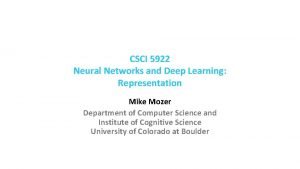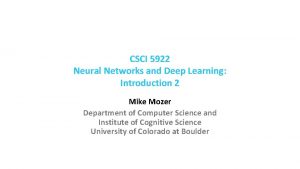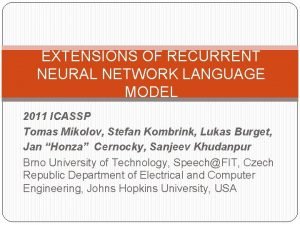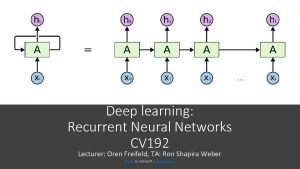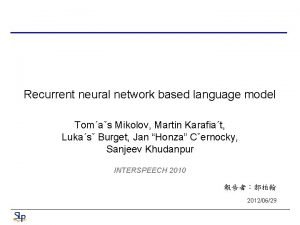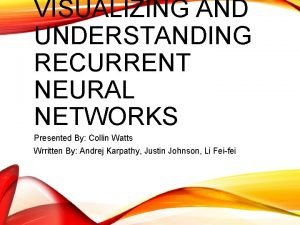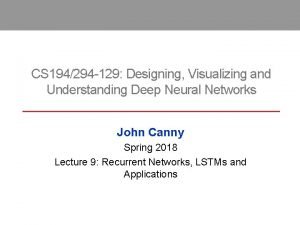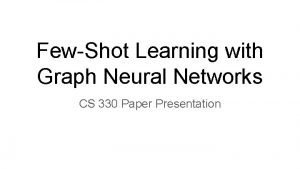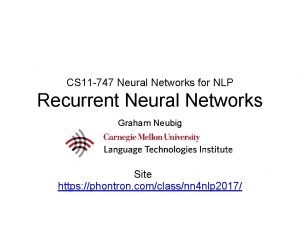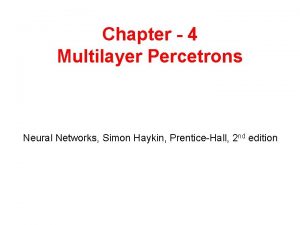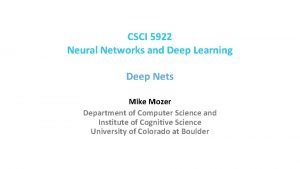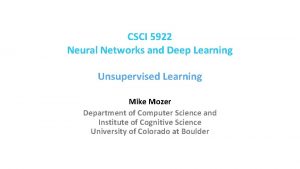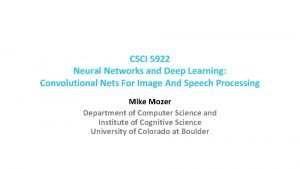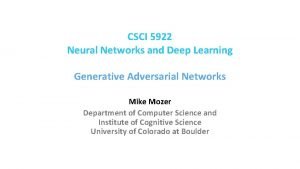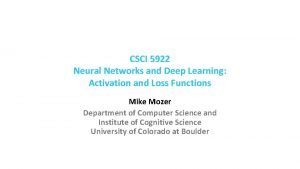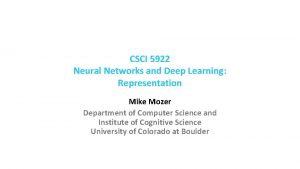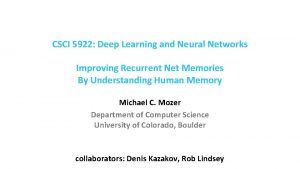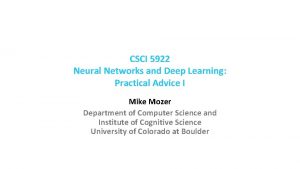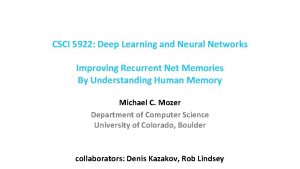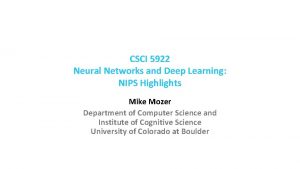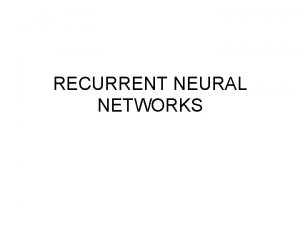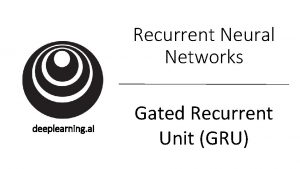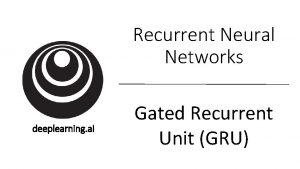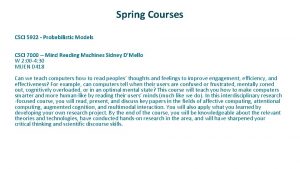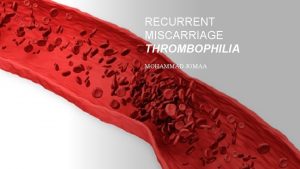CSCI 5922 Neural Networks and Deep Learning Recurrent




























- Slides: 28

CSCI 5922 Neural Networks and Deep Learning: Recurrent Networks Mike Mozer Department of Computer Science and Institute of Cognitive Science University of Colorado at Boulder

Recurrent Neural Nets For Sequence Processing

Challenge ü ü Back propagation is designed for feedforward nets What would it mean to back propagate through a recurrent network? § error signal would have to travel back in time

Unfolding A Recurrent Net ü Requires duplication of hardware (units and weights) § one layer for each discrete time step ü ü Unfolded net has dynamics identical to that of recurrent net run for a fixed number of time steps BP may violate the constraint that corresponding weights are equal. § To enforce the constraint, assume a single set of underlying parameters ü Unfolding is necessary only during learning. § Once weights are trained, can run as an ordinary RNN

Back Propagation Through Time (BPTT) For Sequence Recognition

Alternative To BPTT: Real Time Recurrent Learning (RTRL)

Neural Network Music Composition (Mozer, 1994)

Psychologically Grounded Representation Of Pitch ü Each pitch as point in 5 dimensional space

Analogous Representation Of Duration

Psychologically Grounded Chord Representation ü Hierarchical clustering

Simulation Experiments ü All pieces transposed to common key § C major or A minor ü ü Bach (10 training examples) European folk melodies (25 examples) Waltzes (25 examples with harmonic accompaniment) Outcome § Network learns local structure but not global structure of musical organization

Vanishing gradients are a big problem with recurrent networks Nets cannot learn long-term dependencies

One Solution To Vanishing Gradients: Inject Error At Every Time Step ü Elman autopredictor network § like autoencoder but in time ü Target at each time step is next sequence element § E. g. , “I like to eat bread and …” next hidden current

Truncated Gradient ü ü With training signal at each time step, may be able to get away with truncating the number of steps of back propagation for time efficiency. next(t) hidden(t) next(t-1) current(t) hidden(t-1) next(t-2) current(t-1) hidden(t-2) next(t-3) current(t-2) hidden(t-3) Elman’s cheesy limit current(t-3)

Elman Simulation ü Sentence generator constructs 2 and 3 word utterances using grammar. § woman smash plate § monster eat mouse § dog smell ü 10000 random sentences concatenated to form 27, 354 element sequence § Each word represented by one-hot 30 -bit binary vector ü 30 -50 -30 autoencoder § trained on 5 passes through input stream § (not sufficient to memorize training set)

Grammar + Selection Restrictions

Training Sequence

What Internal Representation Has The Network Learned In Carrying Out Prediction Task? ü ü ü For every instance of a given word in training set, obtain hidden representation. Average representations together to obtain a ‘prototypical’ hidden response. Perform hierarchical cluster analyses on these (50 -element) vectors to determine which words are similar to one another next hidden current

Hierarchical Clustering

Another Solution To Vanishing Gradients y h x

Unfolding the Focused Recurrent Architecture y h x y(t) h(t) x(t) h (t-1) x(t-1) x(t) h(t-2) x(t-2) h(t-3) x(t-3) x(t-1) x(t-2) x(t-3)

Long Short-Term Memory (LSTM) Hochreiter & Schmidhuber (1997) ü

Hinton LSTM Video

LSTM Needs Self Connections For Propagating Gradients And Also Full Connectivity To Construct Representations . . . classification / prediction / translation memory sequence element LSTM . . .

Gated Recurrent Unit (GRU) (Chung, Ahn, & Bengio, 2016) ü

Echo State Networks ü Link to summary paper

Unitary RNNs (Worth Checking Out? )

Bidirectional Recurrent Nets ü y(1) y(2) g (1) y(t-2) g (2) h (1) h (2) x(1) x(2) … … y(t-1) g(t-2) y(t) g (t-1) g(t) h (t-2) h (t-1) h(t) x(t-2) x(t-1) x(t)
 Csci 5922
Csci 5922 Csci 5922
Csci 5922 Deep forest: towards an alternative to deep neural networks
Deep forest: towards an alternative to deep neural networks Pixel recurrent neural networks
Pixel recurrent neural networks Andrew ng recurrent neural networks
Andrew ng recurrent neural networks Mippers
Mippers Efficient processing of deep neural networks pdf
Efficient processing of deep neural networks pdf Least mean square algorithm in neural network
Least mean square algorithm in neural network Neural networks and learning machines
Neural networks and learning machines Extensions of recurrent neural network language model
Extensions of recurrent neural network language model Colah lstm
Colah lstm Karafia
Karafia Visualizing and understanding recurrent networks
Visualizing and understanding recurrent networks Cs 231 n
Cs 231 n Few shot learning with graph neural networks
Few shot learning with graph neural networks Deep learning approach and surface learning approach
Deep learning approach and surface learning approach Visualizing and understanding convolutional neural networks
Visualizing and understanding convolutional neural networks Neural networks for rf and microwave design
Neural networks for rf and microwave design Neural networks and fuzzy logic
Neural networks and fuzzy logic Cmu machine learning
Cmu machine learning Vc bound
Vc bound Localization of function ib psychology
Localization of function ib psychology Audio super resolution using neural networks
Audio super resolution using neural networks Convolutional neural networks for visual recognition
Convolutional neural networks for visual recognition Image style transfer using convolutional neural networks
Image style transfer using convolutional neural networks What is stride in cnn
What is stride in cnn Matlab u-net
Matlab u-net 11-747 neural networks for nlp
11-747 neural networks for nlp Xor problem
Xor problem
